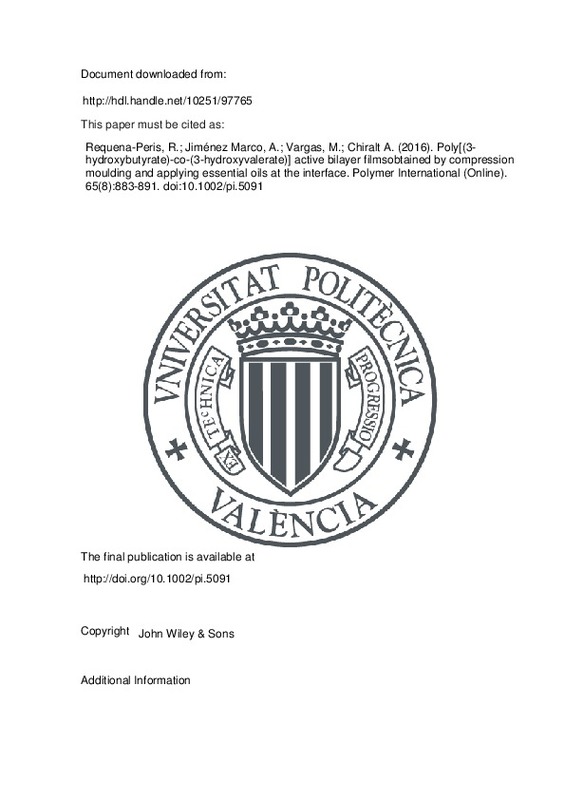JavaScript is disabled for your browser. Some features of this site may not work without it.
Buscar en RiuNet
Listar
Mi cuenta
Estadísticas
Ayuda RiuNet
Admin. UPV
Poly[(3-hydroxybutyrate)-co-(3-hydroxyvalerate)] active bilayer filmsobtained by compression moulding and applying essential oils at the interface
Mostrar el registro sencillo del ítem
Ficheros en el ítem
| dc.contributor.author | Requena-Peris, Raquel
|
es_ES |
| dc.contributor.author | Jiménez Marco, Alberto
|
es_ES |
| dc.contributor.author | Vargas, Maria
|
es_ES |
| dc.contributor.author | Chiralt, A.
|
es_ES |
| dc.date.accessioned | 2018-02-13T08:07:20Z | |
| dc.date.available | 2018-02-13T08:07:20Z | |
| dc.date.issued | 2016 | es_ES |
| dc.identifier.uri | http://hdl.handle.net/10251/97765 | |
| dc.description.abstract | [EN] Four active components, oregano essential oil (OR) and its respective main compound carvacrol (CA) and clove essential oil (CLO) and its respective main compound eugenol (EU), were used separately to obtain, using compression moulding, poly[(3-hydroxybutyrate)-co-(3-hydroxyvalerate)] (PHBV) bilayer films with antimicrobial activity. The active compounds were sprayed (15% w/w, polymer to active compound ratio) at the interface between two layers of PHBV, which were joined using thermo-compression. Tensile, barrier and optical properties, as well as thermal behaviour, of the films were characterized after one week at 25 ∘C and 53% relative humidity. Likewise, the antimicrobial activity of the films was evaluated against Escherichia coli and Listeria innocua. Although the tensile properties of the films were not improved with respect to pure PHBV films by the addition of the active compounds, more transparent materials with better water vapour barrier capacity were obtained. Thermogravimetric analyses showed that CA and EU slightly decreased the polymer thermal stability, while OR and CLO led to more thermally resistant material. Miscibility of actives with the polymer was assessed through the promoted decrease in melting temperature and degree of crystallinity. PHBV films allowed the release of the active compounds in adequate amounts and at adequate rates into culture media to control themicrobial growth of the two tested bacteria. The films were significantly more effective against E. coli than against L. innocua. Both bacteria were more sensitive to OR and to its main compound, CA, due to the greater antimicrobial effectiveness of these components. | es_ES |
| dc.description.sponsorship | The authors thank the Ministerio de Economía y Competitividad – Government of Spain for financial support provided through AGL2013-42989-R Project. RR thanks the Ministerio de Educación, Cultura y Deporte – Government of Spain for an FPU Grant. | |
| dc.language | Inglés | es_ES |
| dc.publisher | John Wiley & Sons | es_ES |
| dc.relation.ispartof | Polymer International (Online) | es_ES |
| dc.rights | Reserva de todos los derechos | es_ES |
| dc.subject | Poly[(3-hydroxybutyrate)-co-(3-hydroxyvalerate)] (PHBV) | es_ES |
| dc.subject | Carvacrol | es_ES |
| dc.subject | Eugenol | es_ES |
| dc.subject | Oregano | es_ES |
| dc.subject | Clove | es_ES |
| dc.subject | Listeria innocua | es_ES |
| dc.subject | Escherichia coli | es_ES |
| dc.subject | Antimicrobial | es_ES |
| dc.subject.classification | TECNOLOGIA DE ALIMENTOS | es_ES |
| dc.title | Poly[(3-hydroxybutyrate)-co-(3-hydroxyvalerate)] active bilayer filmsobtained by compression moulding and applying essential oils at the interface | es_ES |
| dc.type | Artículo | es_ES |
| dc.type | Comunicación en congreso | es_ES |
| dc.identifier.doi | 10.1002/pi.5091 | es_ES |
| dc.relation.projectID | info:eu-repo/grantAgreement/MINECO//AGL2013-42989-R/ES/NUEVOS MATERIALES BIODEGRADABLES MULTICAPA PARA ENVASADO ACTIVO DE ALIMENTOS SENSIBLES AL DETERIORO MICROBIANO Y%2FO OXIDATIVO/ | es_ES |
| dc.rights.accessRights | Abierto | es_ES |
| dc.contributor.affiliation | Universitat Politècnica de València. Departamento de Tecnología de Alimentos - Departament de Tecnologia d'Aliments | es_ES |
| dc.contributor.affiliation | Universitat Politècnica de València. Instituto Universitario de Ingeniería de Alimentos para el Desarrollo - Institut Universitari d'Enginyeria d'Aliments per al Desenvolupament | es_ES |
| dc.description.bibliographicCitation | Requena-Peris, R.; Jiménez Marco, A.; Vargas, M.; Chiralt, A. (2016). Poly[(3-hydroxybutyrate)-co-(3-hydroxyvalerate)] active bilayer filmsobtained by compression moulding and applying essential oils at the interface. Polymer International (Online). 65(8):883-891. doi:10.1002/pi.5091 | es_ES |
| dc.description.accrualMethod | S | es_ES |
| dc.relation.conferencename | 5th International Conference on Biobased and Biodegradable Polymers (BIOPOL 2015) | es_ES |
| dc.relation.conferencedate | October 06-09, 2015 | es_ES |
| dc.relation.conferenceplace | Donostia-San Sebastián, Spain | es_ES |
| dc.relation.publisherversion | http://doi.org/10.1002/pi.5091 | es_ES |
| dc.description.upvformatpinicio | 883 | es_ES |
| dc.description.upvformatpfin | 891 | es_ES |
| dc.type.version | info:eu-repo/semantics/publishedVersion | es_ES |
| dc.description.volume | 65 | es_ES |
| dc.description.issue | 8 | es_ES |
| dc.identifier.eissn | 1097-0126 | es_ES |
| dc.relation.pasarela | S\315545 | es_ES |
| dc.contributor.funder | Ministerio de Economía, Industria y Competitividad | es_ES |







![[Cerrado]](/themes/UPV/images/candado.png)

